3 Technical Innovations for Silver (That You Probably Didn’t Know)
Posted on — Leave a commentInvestors have long been aware of the value that owning silver can add to your portfolio. Silver boasts many of the same diversification benefits as gold, at a much lower price point.
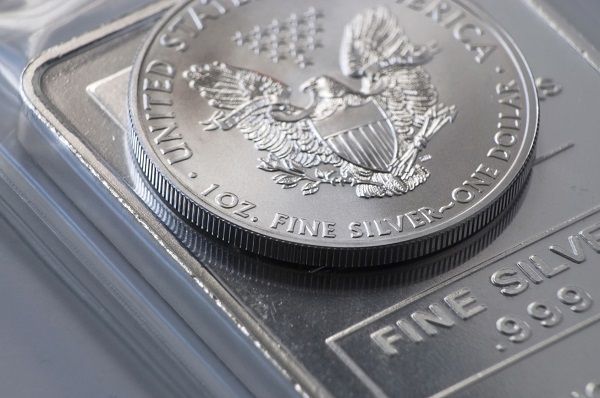
In addition to its value as a precious metals, silver is also a widely used industrial metal. New technical innovations are emerging for silver every year, which is increasing industrial and manufacturing demand for the metal.
Silver is considered the best element to conduct heat and electricity. It also has unique antimicrobial properties, is extremely reflective, which makes it useful for solar panel cells.
Silver demand climbed in 2018 and forecasts are for the rising demand and falling supply to continue.
The latest edition of Silver News highlights the growing demand picture and also several unique uses for silver that you probably never would have guessed:
Antibacterial Silver-Based Paint
Two of Bollywood’s most popular movie stars — Deepika Padukone and Ranbir Kapoor — who
were once an item, are back together in a campaign for antibacterial, silver-based paints called Royale Health Shield, manufactured by Asian Paints.
The video commercial featuring the Bollywood stars for the antibacterial paint has gone viral. The video shows Kapoor choosing the wall color for his renovated home. He asks Padukone for advice and she responds that any color will do as long as it is paint with antibacterial powers.
In a prepared statement, Amit Syngle, COO, Asian Paints Limited said, “Today’s consumer is more aware and believes in making healthy choicesthat are safe and hygienic, especially when it comes to their homes. Asian Paints Royale Health Shield is one such healthy choice for a consumer to make to ensure their walls are bacteria-free. This revolutionary paint contains silver ion technology, as recommended by the Indian Medical Association (IMA), making it the first such paint brand to receive this distinction, Silver News reported.
Healthy Teeth
The California Dental Association (CDA) sponsored legislation to allow Silver Diamine Fluoride (SDF) – an effective and safe cavity prevention option, especially in children – to be covered under the state’s Medi-Cal Dental Program. SDF can stop the progression of tooth decay and stabilize a tooth if further intervention is required.
Silver Keeps Astronauts Healthy at International Space Station
Harmful bacteria can grow just about anywhere. Even in space. The International Space Station has been inhabited since November 2000 faces unique challenges to keep its residents – international astronauts healthy. Not surprisingly, scientists found the toilet door teeming with bacteria. These types of infestations are far more dangerous to astronauts as prolonged time in space is known to reduce one’s immune fighting capabilities.
Silver to the rescue!
Astronauts recently tested a coating of silver and ruthenium called AgXX. Ruthenium is another rare metal with antibacterial powers. International space station astronauts found the effects are similar to bleach!
After long-term testing, they found the AgXX-coated surface had 80 percent fewer bacterial strains compared to an non-coated area of bare steel.
The Bottom Line
Scientists keep finding more and more uses for silver, which will keep demand high and growing in the years to come. Learn about silver investment options here.
Why You Should Diversify into Rare Coins Now
Posted on — Leave a comment“May you live in interesting times.” That old expression is actually a Chinese curse.
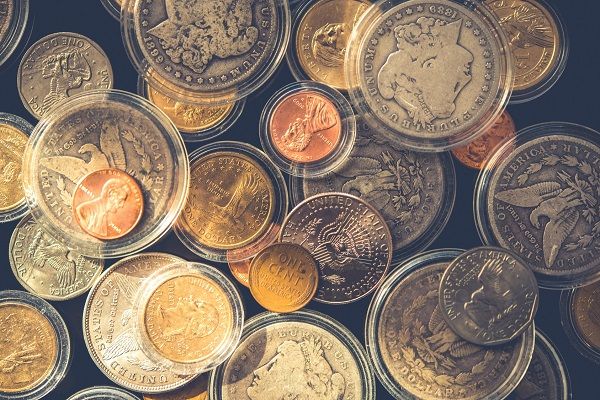
Over the past decade Federal Reserve officials faced more than their share of interesting times, and they may agree it has indeed been a curse. From the 2008 global financial crisis to last year’s December stock market meltdown to unprecedented political pressure from the Administration to cut interest rates to an epic trade war with the world’s second largest economy. It’s a recipe for interesting times indeed.
“Fear Gauge” Skyrockets
It’s been a roller coaster ride for stock market investors since the start of May thanks to tariff induced price swings. The Cboe Volatility Index, commonly known as the “VIX” or the “Fear Gauge” surged to 34% last week well above the index’s historical average at 19. Huge price swings have become common in 2019. Though May 8, the S&P 500 clocked 13 massive price swings of 1% or more. Make no mistake, after years of ultra-low market turbulence, volatility is back with a vengeance.
Interest Rates: Up or Down?
On the interest rate front, never before have we seen the Federal Reserve stuck in such a daunting position.
- On one hand, the Fed is facing public political pressure from the U.S. Administration to cut interest rates.
- On the other hand, many long-time Fed watchers warn that if the central bank fails to hike interest rates to a historically normal range in the 3.5% area, the Fed will be impotent to combat the next recession.
You might say the Fed is stuck between a rock and a hard place.
Then, There’s the Trade War
Choppy waters lie ahead for investors in the wake of the ever-deepening trade war with China. The U.S. increased tariffs on $200 billion of Chinese imports to 25% from 10% last week, which took the Trade War battle between the world’s two biggest economies to a whole new level.
Some economists speculated the U.S.-China trade war could force the Fed to lower interest rates to help soften the blow of the resulting slower economic growth.
- In fact, the exact opposite scenario could be the true outcome. The Fed may be forced to raise interest rates because of the Trade War.
Trade Wars Are Inflationary
Walmart, the world’s largest retailer’s chief financial officer told Reuters this week, that higher tariffs will result in increased prices for consumers.
No matter how anyone spins it, trade wars are inflationary. The 25% tariff is a tax that U.S. businesses must pay when the Chinese imports come into the U.S. That tax will be passed along to U.S. consumers.
“Ultimately consumers are going to be very surprised,” said Peter J. Bragdon, chief administrative officer for Columbia Sportswear Co., said in a Washington Post article.
“They’ve been told they won’t see any rise in prices, and that’s just not true,” Bragdon said.
American families will pay an extra $767 a year on everyday items like suitcases, cribs and clothing following Friday’s tariffs, according to a report by the Trade Partnership, a Washington-based research and consulting firm.
Here’s Why The Fed Could Raise Rates
While the Federal Reserve has been stumped in recent years by the near non-existence of inflation, the trade war could be the catalyst for a big jump in inflation.
“It is possible that Mr. Trump’s tariffs could lift prices in the United States. It might even boost the Federal Reserve’s preferred inflation gauge toward — or over — the central bank’s 2 percent goal,” a May 16 New York Times article stated.
What does this all mean? Answer: The Fed will be forced to raise interest rates to fight back against inflation.
Investors Should Expect More Market Swings
Trade wars, rising inflation, rising interest rates and an aging stock market cycle add up to a bumpy road ahead for stock market investors. The current bull market is now the longest since World War II and market analysts are well aware that volatility increases as markets build major tops.
While we are not predicting a market meltdown, we wouldn’t be surprised if that occurred.
Rebalancing Your Portfolio with Rare Coins
The volatility in the stock market is approaching all-time record highs. With some stocks at record highs, investors are rebalancing their portfolio and increasing their allocation of alternative assets such as rare coins and gold.
Rare coins and gold are non-correlated to the stock market, which means they don’t move together. Typically, during times of equity market stress, gold climbs sharply as investors pile into precious metals seeking safety.
Inflation also has a powerful impact on rare coin values. For example, from 2001 to 2007, the inflation rate in the U.S. went from just under 2% to 4%. Rare coin prices rose substantially during this time. Will this happen again? Just listen to the Federal Reserve. For some time, they have publicly stated a 2% rate of inflation goal. Now, on numerous occasions, the Fed has stated that they feel we will overshoot that rate and that they are okay with that happening. The Trade War may just be the catalyst the Fed was looking for to give them the excuse to hike interest rates sharply in the coming months.
Is your portfolio ready?
The Story of America’s First Minted Coin
Posted on — Leave a commentIn 1783 the monetary system in the United States was something of a mess. There was inconsistency among the coinage used throughout the thirteen states governed by the Articles of Confederation. Some people used coins from other countries and others used money that was unique to their region. The value of goods fluctuated from state to state and the accepted currency also differed. As a result, transactions were burdensome. Customers had to frequently exchange currencies. This step generated additional fees. In time the Continental Congress chose to mint a single currency.
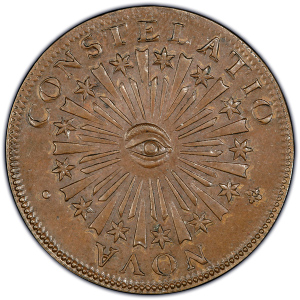
The first step in this project was to assess the different currencies in use and attempt to reconcile their values. The purpose of this initial phase was to devise a currency that could be easily adopted by each of the thirteen states. After evaluating the scope of money in circulation across the states officials decided to use a system based on 1,000 Units. Doing so would equip all but one of the thirteen states to adjust their money to this new system with ease. The resulting currency were the Nova Constellatio pattern coins created in 1783.
Five patterns exist today. The range of values is in three silver denominations of 1,000-Units, 500-Units, 100-Units, and 5-Units. There are two pattern types within the 500-Unit family. The design of each is essentially identical except for the mark indicating the number of units. One side has an all-seeing eye in the center with rays of light radiating out with a circle of thirteen starts to represent each state and the words “Nova Constellatio” surrounding the image. This means “a new constellation.” The reverse features a laurel wreath with the words “Libertas Justitia” (“Liberty, Justice) circling the leaves.
The coins are rare because the plan never came to fruition. The currency never advanced beyond the Congressional committee. In fact, the first official U.S. mint would not open for nearly a decade. This rarity means that few have ever owned the coins and those in existence can be traced back to the men, metallurgist Benjamin Dudley, and founding father Robert Morris, who championed the cause.
It is a sad postscript that Robert Morris later made some highly speculative moves in real estate which left him broke. As a result, he landed in debtor’s prison from 1798 to 1801. After serving his time he spent the remaining, though few, years of his life in Philadelphia until his death in 1806.
Ron Guth, President and Founder of PCGS Coin Facts best encapsulates the importance of the coins when he says “few coins radiate history like the 1783 Nova Constellatio Patterns. They represent an innovative effort to unify the monetary systems of the thirteen colonies, fresh off their defeat of British rule. These once-in-a-lifetime coins reflect the pride, idealism, and hope of a new American nation. Their simple, yet powerful, designs proclaim America’s place as a new constellation in the universe of nations.”
Today the Nova Constellatio coins continue to intrigue collectors because they are the first pattern coins that emerged from the newly independent United States.
3 Resources for Coin Collectors
Posted on — Leave a commentWhen the United States government began minting its first official coins – the 1792 silver half dismes, there were no known coin collectors actively seeking them out.

At the time, American coin collectors pursued ancient Greek and Roman money and European coins.
By the 1850’s that had changed. Philadelphian Joseph Mickley, born in 1799, started collecting coins as a teenager. By the 1850’s, he was the most well-known collector in Philadelphia. His musical instrument repair shop became a gathering place for numismatists who shared stories and knowledge about coins.
If you want opportunities to share and deepen your knowledge for numismatics, here are 3 industry resources to enrich your journey.
- The American Numismatic Association
Located in Colorado Springs, Colorado, the American Numismatic Association is a nonprofit educational organization dedicated to educating and encouraging people to study and collect coins and related items. The ANA serves the academic community, collectors and the general public with an interest in numismatics, according to its website.
The ANA was founded in Chicago in 1891 and has over 25,000 members today. Numismatics can visit the The Edward C. Rochette Money Museum in Colorado Springs.
- The Industry Council for Tangible Assets (ICTA)
Our company founder Jim Blanchard also co-founded this industry advocacy organization, which began in July 1983.
The ICTA was created after 1981 federal legislation, which removed tangible assets from individual retirement accounts (IRAs). Before 1981, Americans could save and invest for retirement with a broad tangible asset portfolio that included artwork, valuable rugs, antiques, rare coins and precious metals. In 1997, bullion products were restored as qualified investment products and efforts to restore rare coins is ongoing.
- Professional Coin Grading Service (PCGS) and Numismatic Guaranty Corporation (NGC)
These two third party grading services are both highly reputable and the accepted industry standard for third party certifications of rare coins. For a nominal fee, individuals can submit a coin for grading, which will be returned certified, graded and sealed in a tamper-evident plastic container known as a “slab.”
Prior to the formation of these firms, dealers graded rare coins in-house, which raised serious conflict of interest issues. The third-party grading services were established to combat this conflict of interest and safeguard the reputation of the numismatic industry. These organizations neither buy nor sell coins, so there are no conflicts of interest.
A Personalized Resource for You
Your Blanchard portfolio manager is a dedicated resource just for you. If you seek knowledge, assistance in crafting a portfolio asset list, or sourcing for a special coin that you’ve hankered after for ages, we can assist. Call Blanchard at 1-800-880-4653 to learn about current market trends in rare coins, our current inventory or to ask even the most basic question. Blanchard is a family run company founded in 1975 and serves over 450,000 clients today.
Only $361.03 of These Coins Were Produced (Face Value)
Posted on — 2 CommentsIt’s big, beautiful and very rare.
It’s also controversial and was only minted for one year, which increases the rarity value of any survivors today.
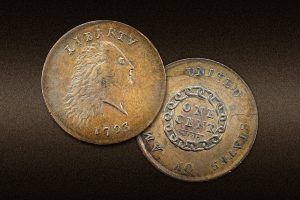
The 1793 Chain Cent is one of the first coins American collectors began acquiring in the 1800’s.
Today, the 1793 Chain cent remains a highly sought after piece of history. The auction record? A cool $1.5 million.
The large Chain copper cent is about the size of a quarter, much larger than modern day pennies. It was the first circulating coin officially produced by the U.S. Mint. A total of 36,103 were struck in 1793, the only year the coin was produced. Only a tiny number of these magnificent Chain Cents have survived over the last 226 years.
Jumping Over Hurdles
U.S. Mint Director David Rittenhouse faced several challenges in the production of the Chain Cent.
Amid rising world copper prices and tight supplies in 1792, Mr. Rittenhouse arranged for imports of sheet copper from Great Britain. He also appealed to Congress and successfully won approval for a reduction in the weight of the cent, from 264 to 208 grains to help cut costs.
A second challenge? The U.S. Mint had no engraver. Rittenhouse persuaded Henry Voight, the chief coiner, to cut the first dies. Voight’s previous experience as a watchmaker left him ill-prepared for engraving.
Nonetheless, Voight went forward and engraved the Chain Cent dies in February 1793.
The Obverse design featured a Liberty head with flowing hair. The reverse featured an interlocking chain with 15 links to represent the existing 15 American states at the time.
The Controversy
An article in the Boston Argus of March 26, 1793 stated: “The chain on the reverse is but a bad omen for Liberty, and Liberty herself appears to be in a fright.”
Liberty’s appearance is likely a result of Voight’s inexperience in engraving. While the chain was intended represent unity and strength of America, critics said it was symbolic of slavery.
The uproar over the Chain cent design sent the government back to the drawing board. The following year, a wreath replaced the chain, and a better Liberty was engraved for the obverse.
Chain Cents are scarce. We have only one. See it here.
Add to Your Collection Today
The study of the history of money is a fascinating journey that opens the door to periods of history with rich detail and little known facts that you might not otherwise have learned.
Looking back and learning gives you a greater appreciation of the significance, artistic excellence and thought and care that drove the minting of early U.S. coins. See our rare coin inventory here.
The World’s Longest Term Investors Are Buying This Now
Posted on — Leave a commentCentral bank reserve managers are buying gold right now. Lots of gold.

What is a central bank? Merriam-Webster defines it this way: “a national bank that operates to establish monetary and fiscal policy and to control the money supply and interest rate.”
Every country has a central bank. In the U.S. it is the Federal Reserve. In England, it’s called the Bank of England. In Australia it’s called the Reserve Bank of Australia. In China, it’s called the People’s Bank of China.
Central banks are some of the longest-term investors around. They are the smart money and they are accumulating gold now.
If some of the smartest minds in the world are buying gold, it makes you think – “Do I own enough gold?”
Consider these 3 facts just released by the World Gold Council:
- Central bank net purchases totaled 145.5 metric tons in the first quarter.
- This central bank gold buying was the strongest first quarter in 6 years.
- A diverse breadth of central banks continued to buy gold: 9 central banks added more than a tonne to their reserves in the first quarter.
Governments and central banks around the world buy gold for the same reason that individuals do – wealth preservation, portfolio diversification, a liquidity source, a hedge against currency devaluation and the list goes on.
The strong central bank gold buying seen in the first quarter of 2019 follows a 50-year high in purchases last year. The relentless gold buying spree continues.
China bought a whopping 33 metric tons in the first three months of 2019. Ecuador, Turkey and India were also notable gold buyers.
How much gold should you own?
Many investors wonder how much gold to buy. It turns out that portfolio allocation research found that investors who hold between 2% to 10% of their portfolio in gold can significantly improve performance.
For example, if you want to maximize protection for your $200,000 retirement portfolio that means it should contain about $20,000 worth of gold. With gold trading at $1,280 an ounce that means you should own about 15 1/2 ounces of gold to effectively diversify your portfolio.
One of the most important attributes that gold has is that it helps investors manage risk more effectively. When the smartest money managers are buying gold for the long-term, shouldn’t you be too?
The Unusual Journey of the Three-Cent Silver Coin
Posted on — 2 CommentsAmerican coinage often follows a strange path. Each piece minted has a unique, twisting history. This characteristic is especially true of the 1858 three-cent silver piece. The coin has origins in the most unlikely place: the post office.
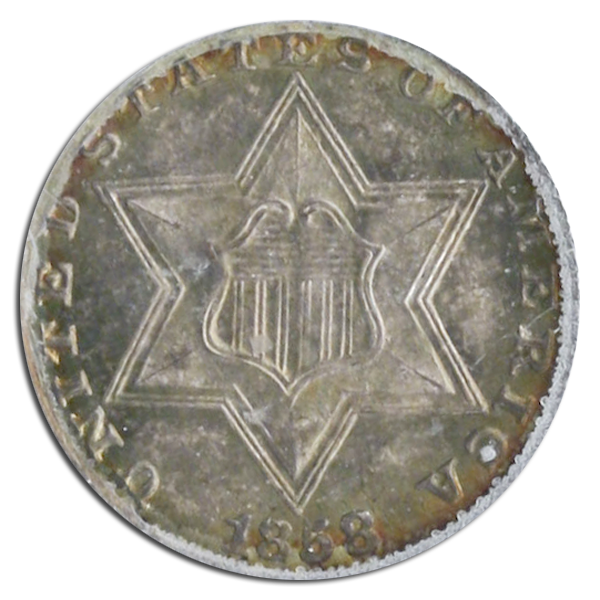
In early 1851 congress began discussing reducing the cost of postage from five cents to three cents. Not long after officials proposed a formal bill to support the minting of a silver, three-cent piece.
While the decision was congruent with the move to change postage rates, historians often note a more important characteristic of the coin: it marked a first for the U.S., as the coin was the first silver piece to consist of a metal that was worth less than the face value.
Previous silver coins were .900 fine. This piece was .750 fine, consisting of three parts silver to one-part copper. In his book Fractional Money: A History of Small Coins and Fractional Paper Currency of the United States, author Neil Carothers writes that “the new piece was the first silver coin in the history of the United States that was not legal tender for an unlimited amount.”
The design of the coin was practical. The simple, uncomplicated imagery accounted for the small size of the piece. One side shows a star with the shield of the Union inside. The reverse side shows an ornamental letter C with the Roman numeral III inside. Thirteen stars form a circle around the edge. Later versions of the coin would include olive branches above and below the Roman numeral. After designing the piece, the coin entered production that extended into three phases:
- Phase I 1851-1853
- Phase II 1854–1858
- Phase III 1859–1873
Phase 1
The Philadelphia Mint struck 5,446,400 pieces in 1851. At the same time officials struck an additional 720,000 in New Orleans. Public reception was not favorable. Many believed the coins were too small and easily lost.
Phase 2
The US government decided to increase the composition to .900 silver. The impetus for this change was a desire to push Spanish silver coins out of circulation. This change, however, meant that the government had to purchase large quantities of silver for minting. The 1858 coin represents the largest minting with a total of 1,603,700 struck.
Phase 3
The final phase of production occurred before, during, and after the civil war. During the war the government introduced legal tender notes backed only by faith in the credit standing of the government rather than a precious metal.
In time, production ended because the U.S. no longer had a need for the coin. Many pieces from the 1863 production and after were retained by the treasury and ultimately melted after officials decided to cease minting.
Today, the coin’s value varies greatly based on year and condition. One extreme end of the spectrum is an 1851 proof of the three-cent piece which sold in 2012 for $172,500. This particular coin is the only known of its kind in existence. Collectors value the history of the coin and the role it played during a long, and formative period of US history.
3 Famous Coin Hoards
Posted on — Leave a commentFor centuries people buried and hoarded coins for many reasons.

In ancient times, many coin hoards were buried during times of war. Other coin hoards began in the wake of the Great Depression by those who distrusted banks and paper money and preferred to store their life savings at home.
People who buried the coins typically planned to come back and retrieve the treasure, yet that wasn’t always possible. Even today, there are ancient coin hoards found in the Mediterranean region dating back to the Greek and Roman eras.
The discovery of a true coin hoard is an exciting numismatic event. It opens the door for collectors to obtain a rare coin perhaps even in mint condition. Here’s a look at the history behind three famous U.S. coin hoards.
The Economite Treasure
In 1878, a notable hoard of silver coins was discovered in an underground storage area in Economy, Pennsylvania.
Around 1836, members of the so-called Harmony Society, which claimed to be a utopian work-share community sealed about $75,000 face value of U.S. silver coins in a vault and covered it in brick and mortar. Today, the communal group known as the “Rappites” would be regarded as a cult. The coins were found 42 years later, many blackened and tarnished from their years in the damp vault. Coins discovered in that hoard included 400 quarters minted from 1818-1828, 800 Flowing Hair Half Dollars minted from 1794- 1795, 3,500 Large Eagle Draped Bust half dollars minted from 1801-1807 and other assorted silver dollars and half dollars. After the discovery, a Philadelphia dealer bought most of the rarer pieces paying $6,500 for coins worth $4,000 in face value.
Binion Hoard
Ted Binion was the youngest son of casino tycoon Ben Binion, who opened the Binion’s Horseshoe Casino in Las Vegas in 1951. Son Ted grew up working different jobs at his father’s casino and was well-respected for his gambling acumen. Later in life, however, he began associating with a rough crowd, which ultimately led to the loss of his casino license and led to nefarious circumstances surrounding his death. In the wake of Ted’s passing in 1998, law enforcement officials discovered a 12-foot deep vault on his property in Pahrump, Nevada, which held roughly $7 million in treasure including over 100,000 Morgan and Peace silver dollars.
The Saddle Ridge Hoard
Many of you are probably familiar with the more recent Saddle Ridge Hoard, the largest discovery of buried gold coins ever recorded in the United States. In 2013, a married couple was out walking their dog on their rural California property. They spotted a rust covered metal can partially visible in the dirt. Upon further exploration they discovered the first gold coin of many. The 1,427 gold coins minted from 1847 to 1894 were valued at over $10 million.
Who knows why those gold coins were buried, or why they never came back to get their hoard.
Collector’s Paradise
Finding a coin hoard could happen to anyone. It could be a small coin hoard in an elderly relative’s floorboards or a buried vault on a rural property. Sadly, there are likely many coin hoards still out there today that may never be found.
Nearly all Financial Analysts Today Agree on One Thing
Posted on — Leave a commentWhile the most difficult days of the 2008 global financial crisis are behind us, the reverberations are still felt today.

During that period of financial upheaval central banks took steps to increase the money supply by purchasing government securities. This practice, known as quantitative easing, lowers the cost of money. As a result, banks can lend more freely and relax their terms. Businesses can more easily infuse capital into their enterprise and pursue growth. Quantitative easing was a major tool in the reconstruction effort during the bottom of the economic collapse that has come to define the first decade of the 21st century.
Today, the government is taking steps to walk back from this line.
They are increasing interest rates in a moderate fashion. The cost of money is now increasing. With capital becoming more expensive, businesses are struggling to find other ways to grow. Like a healing ankle sprain, the economy has left the crutches aside and is struggling to walk unassisted. For this reason many analysts expect the coming years to offer only modest stock market returns.
“Market returns on stocks and bonds over the next decade are expected to fall short of historical averages,” remark analysts at Charles Schwab.
As the government takes steps to increase the federal funds rate the available money supply is decreasing. Since the global financial crisis, businesses have grown accustomed to this once inexpensive source of funding and growth. By the start of 2009 this rate was near zero reaching a low-point of just 0.07 percent.
Today, this number has climbed to just over 2.40 percent. Expectations of decreased annual returns in the equity market are a rare point of agreement across organizations. Investment behemoth Vanguard, overseeing more than $4 trillion in invested assets, expect the classic portfolio allocation of 60 percent stock and 40 percent bonds, to deliver two-to-three percentage points less than what we have seen in previous decades.
As with all bad news, there is some good buried within.
These forecasts still leave investors with time to re-tool their asset allocation strategy and position themselves to reach for gains elsewhere when they’re not available in the stock and bond market. For many investors, gold is the answer.
Though interest rates have little, or no correlation to gold prices investors should consider the historical relationship between gold and equity prices. In September 2007 – the dawn of the financial crisis – the S&P 500 stood at 1,539 before falling over 20% by September of 2011. Meanwhile, gold increased from $712 per ounce to $1,778 per ounce over the same period.
The key takeaway is that analysts are united in their opinion that we stand at the beginning of an era of lower-than-average equity returns. This forecast, however, doesn’t mean that investors must resign themselves to the whims of a turbulent market. Instead, this early message offers an opportunity to rebalance portfolios in a way that defrays risk and increases the possibilities for boosting returns.
Get over this Psychological Hurdle to Save for Retirement
Posted on — Leave a commentWhen you are in your 20s, 30s or even 40s, retirement can seem like a distant reality. That makes it hard to save for retirement. But, in reality, experts suggest you should save 10%, 20% or even 30% of your monthly income toward retirement.

Behavioral economists say the biggest obstacle for younger people to save for retirement is a phenomenon called “psychological distance.” That simply means how far away something feels in our mind’s eye.
The greater the psychological distance, the less importance we place on things. What happens today feels more important than what will happen in 20 or 30 years. So people spend today and put off saving until next year. But, when it rolls around to next year, many people do the same.
Don’t make mistakes now that your “future self” will regret.
What’s the solution?
Start connecting to your “future self.”
Fascinating research by Dr. Hal Hershfield and his colleagues at Stanford University revealed that people who feel more connected to their future self save more and accumulate greater assets than those who are disconnected from their future self.
The researchers found that when people interacted with an age-progressed avatar of themselves, they made more future-oriented financial choices afterward.
Age-progress a picture of yourself right now. There are free apps and online tools to do this with a photo and you can imagine what it will feel like to be elderly. Consider what you want your life to be like then. What do you want your bank account to look like at that age? Imagine what it would feel like to have a lot of money or a little.
You can also use behavioral hacks recommended in research by Nobel Laureate Richard Thaler of the University of Chicago. His advice is “Save More Later.”
What that means is commit now to saving more when you get your raise next year. This minimizes the influence of loss aversion.
Decide now to increase your monthly contribution to your savings, retirement or tangible asset investments when that salary increase kicks in. By committing to save your raise rather than your current salary, it lessens the pain we feel in setting that money aside.
What else is important for successful retirement? Regular investments in an asset that will protect your purchasing power.
Investing regularly in physical gold is a great strategy to diversify your monthly contributions to an employer sponsored 401k plan or an individual IRA.
Prices when you retire will be much higher than they are today.
It is easy to forget about that important fact when you determine how much you need to save for retirement.
For example, if you want to retire in 25 years, and live a lifestyle that would cost $50,000 today, then that same lifestyle will cost $87,500 in 25 years, if we have 3% yearly inflation.
Just imagine what could happen if inflation jumps up to 12% like we saw in the 1970s. That same $50,000 lifestyle would cost $150,000 a year with 12% inflation.
You need to think about prices being three, four or more times as high as today.
Save early. Save often. Invest and diversify. Gold acts as an insurance policy, a hedge against equity market declines and a vehicle to protect and grow wealth. By owning physical gold, an investor is diversified which results in a better performing portfolio.
Get started today. Your future self will thank you. You can even add precious metals to a self-directed IRA account. Learn how here.








